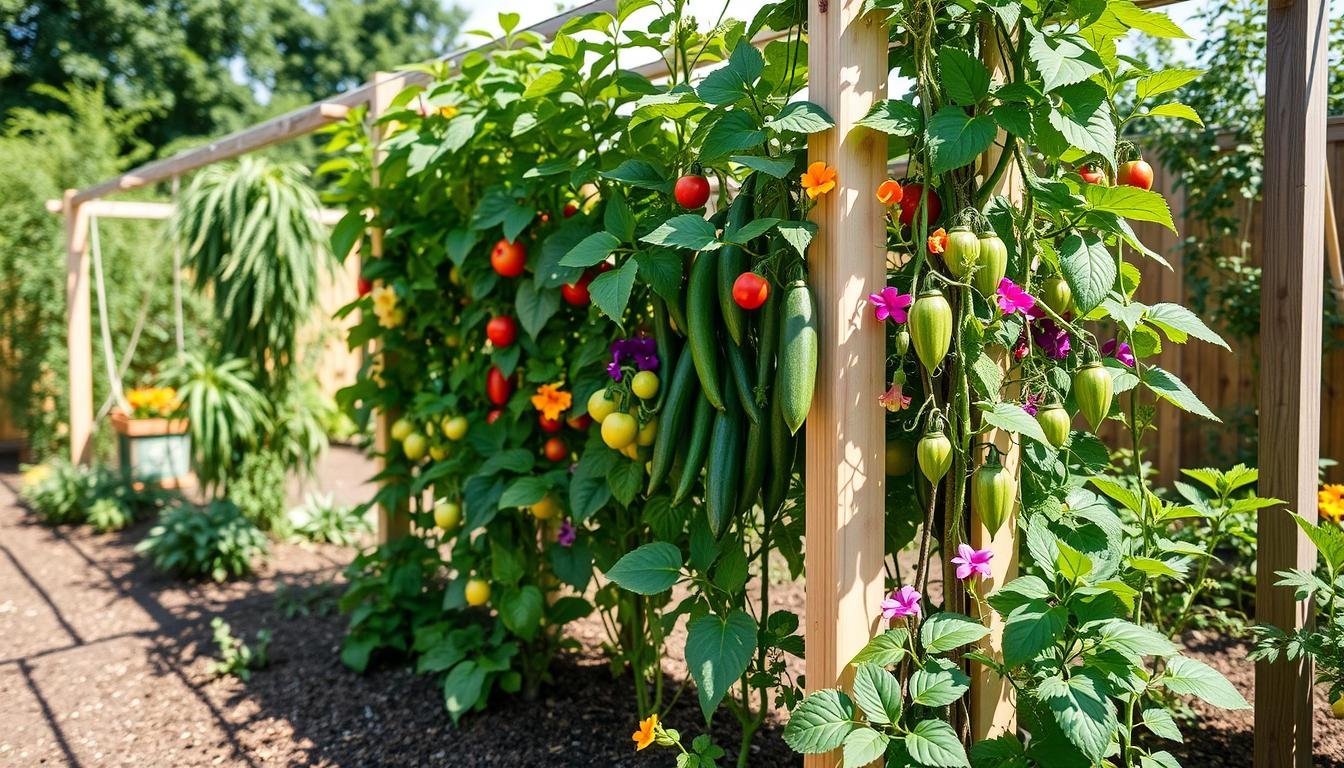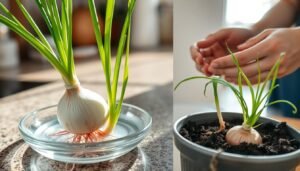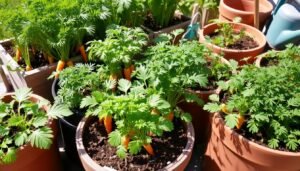Using trellises for vertical gardening is a smart way to save space. It’s perfect for plants like tomatoes, beans, peas, squashes, and cucumbers. Trellises can be fancy or simple, from beautiful walkways to basic frames made of sticks and string.
Vertical gardening has many benefits. It keeps pests away, improves air flow, and makes it easier to care for and pick your veggies. It also helps plants grow more fruit.
Table of Contents
Understanding Vertical Gardening Benefits
Vertical gardening is a big win for those with small spaces or living in the city. It lets you grow more plants in a tiny area. This method also improves air flow and makes caring for your garden easier.
Space Optimization and Yield Increase
Vertical gardening saves space by letting vines grow up instead of out. This means you can grow more plants in a smaller area. You can even use walls, fences, balconies, and to grow your plants, opening up more space for gardening.
Better Air Circulation and Disease Prevention
Plants grown vertically get more air, which helps prevent diseases and pests. They are less likely to get sick from the soil, keeping them healthy and strong.
Easier Harvesting and Maintenance
Vertical gardening makes it easy to weed, prune, and harvest without bending. This is great for anyone who wants to avoid straining their back or for those with mobility issues. It makes gardening more efficient and enjoyable.
“Vertical gardening promotes healthier plants by providing better sun exposure and airflow, leading to cleaner and better-looking crops with fewer blemishes.”
By using vertical gardening, you can turn a small or urban space into a lush, productive garden. It will give you a great harvest and make your garden look amazing.
Essential Types of Vegetable Trellis Structures
Vertical gardening lets you use your space better. You can grow plants like tomatoes, beans, and cucumbers. Trellises come in many types to help these plants grow up, making your garden look great.
Using trellises makes your plants healthier and easier to care for. They also help keep pests away and improve air flow. This means you can grow more and get better results.
Vegetable trellises can be simple or fancy. They can even be walkways. Here are the main types of trellises for growing climbing plants:
- A-frame Trellises are strong and easy to make. They also have space for greens that like shade.
- Wire Panel Trellises are fixed to beds for a sleek look.
- Arch Trellises make fun paths. They’re great for beans and cucumbers.
- String Trellises use twine or netting for support.
- Ladder Trellises are pretty and useful. They’re good for tomatoes and small pumpkins.
Choosing the right trellis depends on your plants’ needs. The right one can make your garden both productive and beautiful.
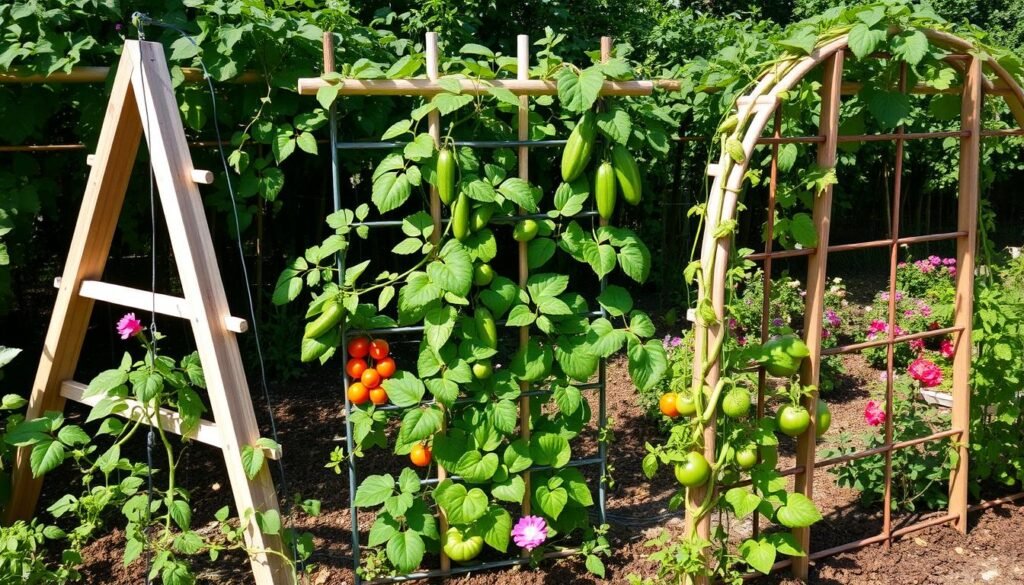
How to Grow Vegetables on Trellis Successfully
Trellis gardening is a great way to grow veggies without taking up much space. To make your vertical garden thrive, start with good soil and the right planting methods. Here’s how to help your trellis-grown crops succeed:
Soil Preparation and Planting Techniques
First, prepare the soil before putting up your trellis. This keeps the roots safe during setup. When planting, remember the spacing for trellised veggies is different from ground plants. For example, plant two cucumber or melon plants per 4-foot section of trellis. Space bean or pea seeds every 4 inches at the base.
Training Plants to Climb
Some veggies, like pole beans and cucumbers, climb naturally. Tomatoes need a little help to grow up. Use soft ties or clips to guide the stems without harming the plants.
Support Systems for Heavy Fruits
For big, heavy fruits like melons or winter squash, add extra support. Hang developing fruits in pantyhose or mesh bags. This keeps the fruits straight and clean, preventing stem damage.
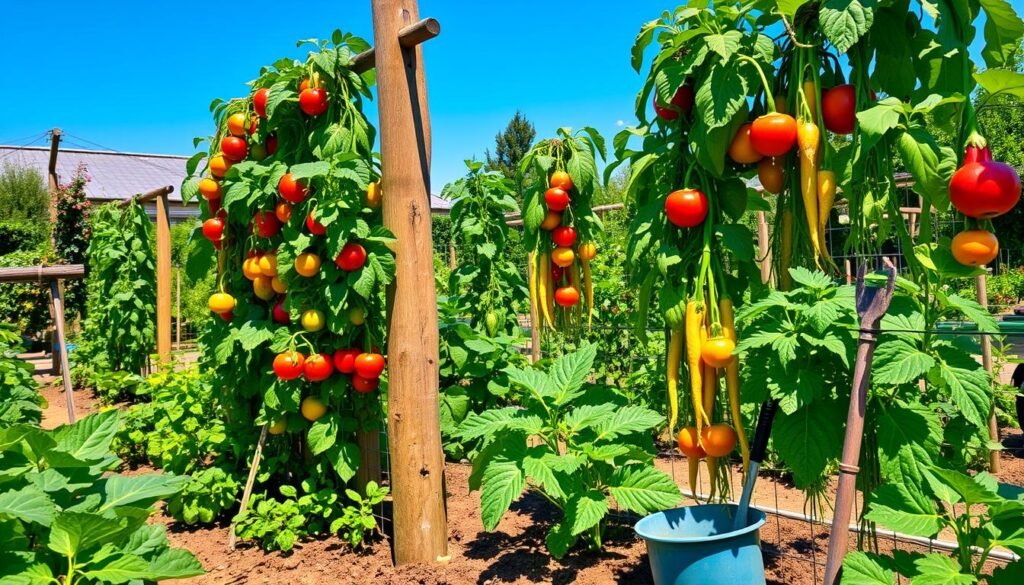
By using these trellis gardening tips, you can make your veggie garden more productive. Enjoy a big harvest in a small space.
Best Vegetables for Trellis Growing
Maximizing your vertical garden is easier with the right climbing vegetable plants on trellises. These vertical garden vegetables save space and boost your harvest.
Pole beans are a top pick. They climb well and yield more than bush beans. Peas are also great, climbing easily in both warm and cool weather.
- Cucumbers on trellises avoid diseases, making them perfect for trellis gardening.
- Indeterminate tomatoes grow taller and produce more when trained to climb.
- Small melons, like cantaloupe and honeydew, fit well on sturdy trellises, saving space.
- Winter squash can grow vertically with the right support, despite their size.
Adding these climbing plants to your trellis system can make your vertical garden thrive. Enjoy a rich harvest in a small space.
“Vertical gardening with trellises allows me to grow a diverse range of vegetables in a small backyard, maximizing my yield without sacrificing precious ground space.”
Trellis Design and Installation in Raised Beds
Using trellises in your raised bed gardening can really help. When setting up your trellis, think about the materials, where to put it, and how big it should be.
Material Selection for Durability
Pick materials that can handle the weather and support your plants. Metal mesh, wooden frames, or cattle panels are great because they last long. Make sure they also look good with your garden.
Proper Positioning and Anchoring
Put your trellis on the north side to keep other plants from getting too much shade. For permanent trellises, use screws or nails to attach them to the bed. Temporary ones need to be anchored well so they don’t fall over.
Size and Height Considerations
The height of your trellis depends on what you’re growing. Tomatoes might need tall trellises, while cucumbers and other vines do well with shorter ones. Plan your trellis installation carefully to support your raised bed gardening plants well.
| Vegetable | Recommended Trellis Height |
|---|---|
| Indeterminate Tomatoes | 6-7 feet |
| Cucumbers | 4-5 feet |
| Pole Beans | 5-6 feet |
| Peas | 3-4 feet |
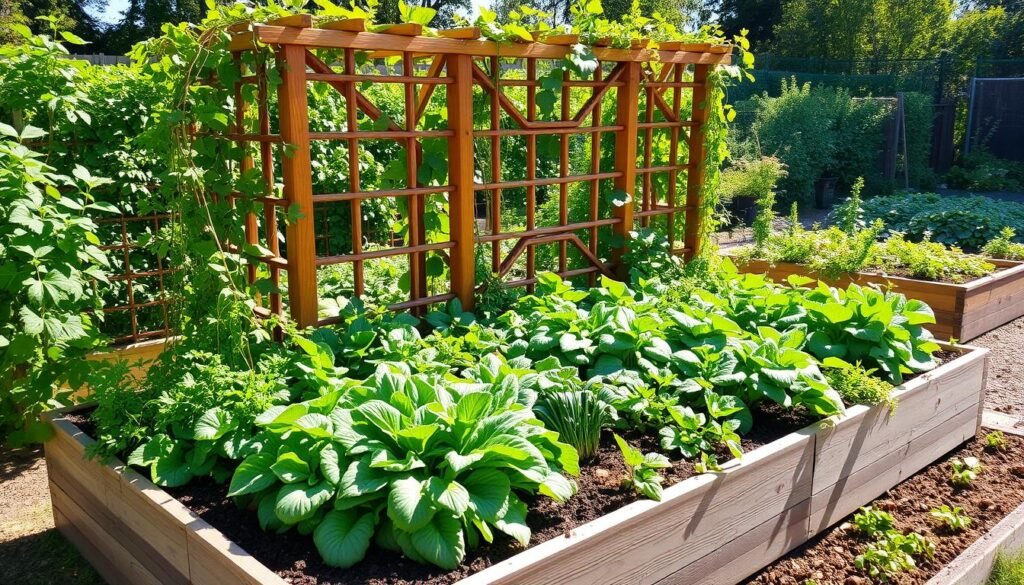
“Trellises in raised beds allow me to maximize my garden space and grow a wider variety of vegetables. The key is finding the right materials and positioning the structures to support the specific plants I’m growing.”
Seasonal Maintenance and Care Tips
Keeping your trellis-grown veggies in top shape needs regular care. Start by trimming and guiding new shoots onto the trellis. This keeps plants healthy, improves air flow, and supports growing fruits or veggies.
Check your trellis often for damage or wear. Fix or replace it as needed, more so for heavy crops like tomatoes and squash. They can put a lot of weight on the trellis.
Make sure your plants get enough water and nutrients. They dry out quicker because they’re higher up. Water them more often and use the right fertilizer for your crops.
- Quickly pick up any fallen or sick leaves to keep plants healthy and stop disease spread.
- When the season ends, clean and store any removable trellises. Fix any permanent ones for winter by removing debris and making repairs.
By sticking to these trellis gardening maintenance and vertical garden care advice, your trellised veggies will flourish. They’ll keep giving you a rich harvest all season long.
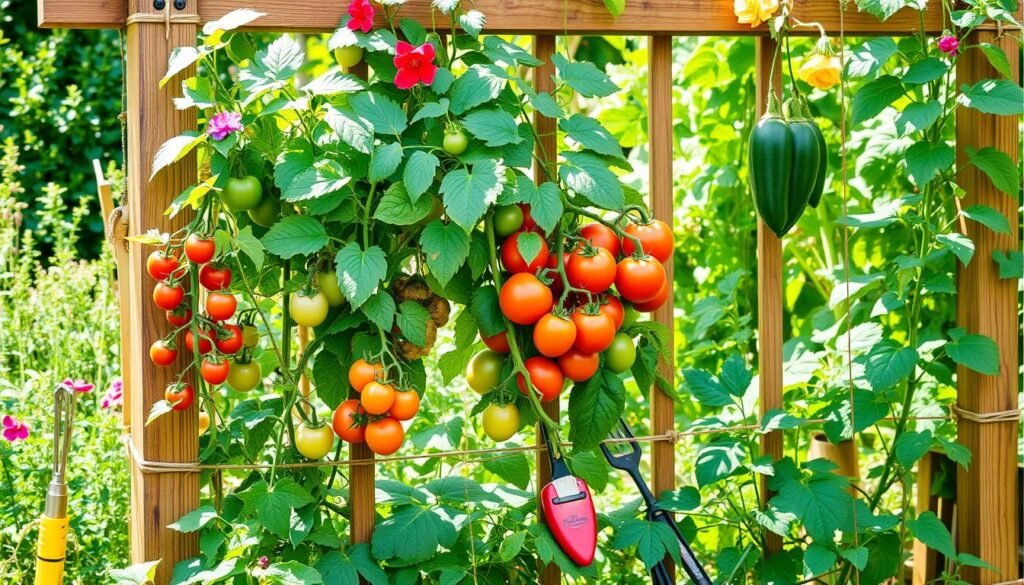
Common Challenges and Solutions
Trellis gardening has many benefits but also some challenges. Gardeners need to know how to handle pests, protect from weather, and ensure structural support. Understanding these issues and finding solutions is key to a successful vertical garden.
Pest Management Strategies
It’s important to check your trellis plants often for pests. Using organic pest control like neem oil or insecticidal soaps is a good choice. It keeps your garden safe without harming the environment. Also, make sure plants have good air flow to prevent disease.
Weather Protection Methods
Keeping your plants safe from bad weather is vital. Use row covers or create windbreaks to protect against strong winds and frost. Also, provide shade for plants that need it to avoid sun damage.
Structural Support Issues
As plants grow and get heavier, they need more support. Reinforce your trellises during the growing season to avoid breakage. For big fruits like melons, use slings from pantyhose or mesh bags for extra support.
By tackling these challenges, you can make your trellis garden a success. With the right pest control, weather protection, and support, you’ll enjoy a great harvest. Remember, vertical gardening is a great way to grow food, even in small spaces.
Space-Saving Trellis Combinations
Make the most of your garden by trying out creative trellis combinations. Use compact vegetable gardening to grow fast crops like peas in spring. Then, plant slow-growing vines like cucumbers for a second harvest. Double-sided trellises let you grow two different crops, doubling your yield without taking up more space.
Take your garden to new levels with living walls. Plant leafy greens or herbs at the base of your trellis. This lets the vines above grow well. For fun, add vertical strawberry planters to your trellis. Arch-shaped trellises not only support plants but also make your garden look great and functional.
By mixing different trellis ideas, you can make your garden more productive and beautiful. Use space-saving trellis combinations to get a big harvest, even in small spaces.

